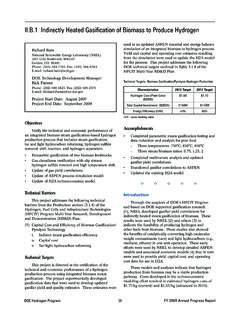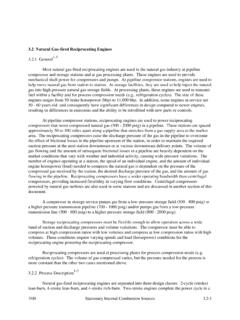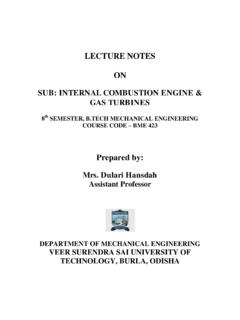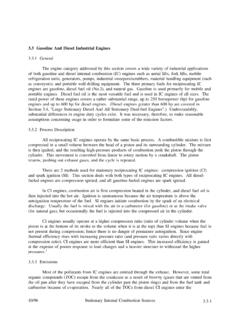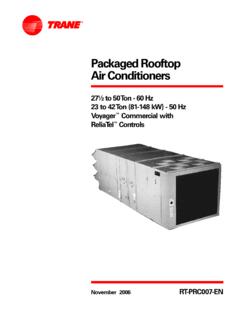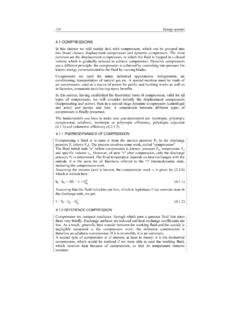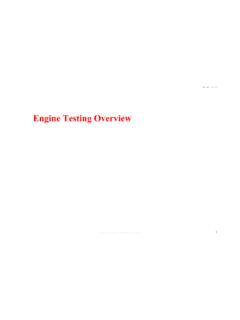Transcription of Advanced Hydrogen Liquefaction Process - Energy
1 Project IDPD018 Advanced Hydrogen Liquefaction ProcessContract Number: DE-FG36-08GO18063 Joe SchwartzPraxair - Tonawanda, NYDOE Annual Merit Review MeetingMay 10, 2011 Copyright 2011 Praxair Technology, paper was written with support of the Department of Energy under Contract No. Government reserves for itself and others acting on its behalf a royalty-free, nonexclusive, irrevocable, worldwidelicense for Governmental purposes to publish, distribute, translate, duplicate, exhibit, and perform this copyrighted presentation does not contain any proprietary, confidential, or otherwise restricted presentation does not contain any proprietary, confidential, or otherwise restricted information2 Phase IIOverviewProgram TimelineCurrent BudgetBarriers Addressed C.
2 High Cost and Low Energy Efficiency of Hydrogen Liquefaction Improved efficiency Improved overall Process by integration Reduced capital costTotalSpent(as of March 1)DOE800,000667,684 Praxair200,000166,921 TOTAL1,000,000834,6057/08 12/09 1/10 12/10 1/11-12/11 Phase I Feasibility1 Develop Alternative Hydrogen Liquefaction Processes2 Validate Ortho-Para Conversion Process Performance Phase II Hydrogen Liquefaction Process Development3 Establish Efficiency, Equipment, and Material Performance Targets4 Evaluate Potential Cost Reduction and Efficiency Improvement Phase III Process Performance Evaluation5 Demonstrate Improved Ortho-Para Conversion Process6 Estimate Capital Cost100% CompletePhase IPhase IIIThis presentation does not contain any proprietary, confidential.
3 Or otherwise restricted information3 Hydrogen LiquefactionExisting Process Flow Diagram Existing Process is highly integrated with air separation Liquid nitrogen typically used as a coolant in the processThis presentation does not contain any proprietary, confidential, or otherwise restricted information4 Joule-Thomson Inversion Curve Hydrogen will cool upon expansion only if it is already cold Hydrogen has an exceptionally low critical temperature (33 K) N2(126 K), O2(155), CH4(190), Ar (151), CO (133), Kr (209), Xe (290) all have inversion temperatures about 5 * TcritExpansioncauses heatingExpansioncauses cooling* From Scott, et al.
4 Technology and Uses of Liquid Hydrogen , , The MacMillan Company, New York, presentation does not contain any proprietary, confidential, or otherwise restricted information5 Hydrogen Liquefier Equipment Design ConsiderationsComponentState of the ArtNear TermLong TermCompressorsReciprocatingScrewRecipro catingCentrifugalCentrifugalHydride Guided RotorPre-CoolingLiquid N2 Mixed gasMagneticLow-Temp RefrigerationReverse BraytonReverse Brayton with Advanced turbinesMagneticAcousticHeat ExchangersBrazed aluminumBrazed aluminum Micro-channelMicro-channelOrtho-Para ConversionCatalytic conversionImproved ortho-para processAdvanced ortho-para processThis presentation does not contain any proprietary, confidential.
5 Or otherwise restricted information6 Program - Develop a low-cost Hydrogen Liquefaction system for 30 and 300 tons/day that meets or exceeds DOE targets for 2012 Improve Liquefaction Energy efficiency from 14 kWh/kg (2005 status) to 11 kWh/kg (2012 goal) - 22% improvement Reduce liquefier capital cost Integrate improved Process equipment Integrate improved ortho-para conversion Process Develop optimized new Liquefaction Process based on new equipment and new ortho-para conversion Process Phase II Process Development Establish performance targets for Process equipment and ortho-para conversion to meet the cumulative efficiency improvement required by the 2012 goal (22% improvement)
6 Objectives -RelevanceThis presentation does not contain any proprietary, confidential, or otherwise restricted information7 DOE Targets RelevanceCategory2005 Status20122017 Small-Scale Liquefaction (30,000 kg H2/day)Installed Capital Cost ($)$50M$40M$30 MEnergy Efficiency (%)70%75%85%Large-Scale Liquefaction (300,000 kg H2/day)Installed Capital Cost ($)$170M$130M$100 MEnergy Efficiency (%)80%>80%87%Efficiency =Liquefied Hydrogen LHVL iquefied Hydrogen LHV + Liquefaction EnergyThis presentation does not contain any proprietary, confidential, or otherwise restricted information8 Hydrogen Delivery -Relevance Pipeline (~ 1 billion scfd) Refineries and other large Hydrogen consumers Liquid (~ 10 million scfd)
7 Million scf/truck Liquefaction is Energy intensive and expensive Liquid serves an important market segment Tube Trailers 125,000 scf/truck Cylinders 250 scf/cylinderThis presentation does not contain any proprietary, confidential, or otherwise restricted information9 Hydrogen Distribution -Relevance Both weigh about 80,000 lbs Liquid Hydrogen might not be the best way to supply the Hydrogen Economy , but it will play a significant role in the transition periodLiquid Tanker4500 kg H2 Tube Trailer300 kg H2 This presentation does not contain any proprietary, confidential, or otherwise restricted information10 Forms of Molecular Hydrogen Difference is due to proton spin Normal Hydrogen is 75% Ortho, 25% Para Equilibrium Liquid Hydrogen is Ortho, Para Ortho-Para conversion requires 18 -45% of the minimum work requirement for Liquefaction * Depends on the conversion Process used No sensible heat removed* From Baker, C.
8 R. and Shaner, R. L. A Study of the Efficiency of Hydrogen Liquefaction ,Int. J. Hydrogen Energy , v. 3, p. 321, +H+H+H+This presentation does not contain any proprietary, confidential, or otherwise restricted information11010203040506070809010005010 0150200250300 Temperature (K)% ParaBoiling PointEquilibrium Composition Para fraction increases as temperature approaches liquid range Catalyst is used to reach equilibrium composition during coolingThis presentation does not contain any proprietary, confidential, or otherwise restricted information12 Ortho-Para Enthalpy Heat of Liquefaction /vaporization is 192 Btu/lb Heat of conversion from n-H2to e-H2in liquid is higherFrom Singleton, A.
9 H. and Lapin, A. Design of Para-Orthohydrogen Catalytic Reactors,Adv. Cryo. Eng., v. 11, p. 617, presentation does not contain any proprietary, confidential, or otherwise restricted information13 Why It Matters -Boil-Off LossCalculated values from: Gursu, S. et al. An Optimization Study of Liquid Hydrogen Boil-Off Losses,Int. J. Hydrogen Energy ., v. 17, p. 227, 1992. Heat of conversion from normal to para is higher than the heat of Liquefaction Spontaneous conversion in the storage tank can cause vaporizationThis presentation does not contain any proprietary, confidential, or otherwise restricted information14 Program Approach Build on successful high-risk, low-effort program funded through EMTEC $200.
10 000 program that demonstrated potential for improved ortho-para conversion Process Enabled Praxair to propose this project to advance Hydrogen Liquefaction Process development Expand program to incorporate other Process improvements beyond improved ortho-para conversion to increase efficiency and reduce cost Design a Process with higher efficiency Implement improved Process equipment Optimize improved ortho-para conversion processThis presentation does not contain any proprietary, confidential, or otherwise restricted information15 Milestones -Approach Phase I -Feasibility Develop Novel Conceptual Process Designs Validate Improved Ortho-Para Performance Phase II - Process Development Establish Performance Targets Evaluate Process Efficiency Phase III Performance Evaluation Demonstrate Ortho-Para Performance Validate Capital Cost and Performance ImprovementThis presentation does not contain any proprietary, confidential, or otherwise restricted information16 Phase II Plan -Approach Process Optimization, Design.



